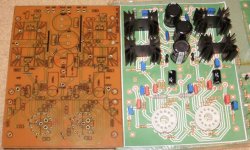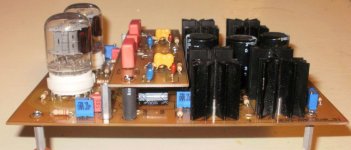I would like to know more about transistors - to design regulators and such. Alas, I only know about tubes so for me tubes are the only choice - can't design an hybrid amp even if my life depended on it. I have mosfets and plenty of transistors laying around. I just need to learn to design an output stage. Dammit. It's like having money that I can't spend - a little frustrating.
Not that difficult, really, and in many ways, SS design is a good deal easier. Transistors, being very high gain devices, even when employed in low gain circuits, are very "transparent". Not sonically transparent, but in the sense that a particular circuit will operate the same way regardless of actual transistor type. Of course, if you happen to come up with a hideous sounding design, you won't help it through "transistor rolling". Start over.
There's no need to worry about whether to use a 6SL7 v. a 6SN7 v. a 12AU7 v..., well, you get the idea. Unless you need some special property -- an unusually low noise figure, or an especially high voltage operation, or something like that, so long as the transistor can process the proposed signal frequencies, the actual types don't matter. I've done many a project with those 15 pack of "transistors anonymous" you get at Rat Shack for a buck-fifty.
As for learning: Google for Design of Modern Transistor Circuits by Maurice Yunik (strong on designs using BJTs, but weak on FETs -- disregard that chapter) or Practical Analysis of Electronic Circuits Through Experimentation by Lorne MacDonald (good info on FETs of all types). Or take a look at manufacturer's application notes.
Most of what you already know transfers over pretty easily. This is especially true if you want to design voltage regulators or CCS's.
Member
Joined 2009
Paid Member
Now what if my amp is hated by some who hate SE, by some who hate tubes, and by some who hate SS devices?
then you're in big trouble !
.......As for learning: Google for Design of Modern Transistor Circuits by Maurice Yunik (strong on designs using BJTs, but weak on FETs -- disregard that chapter) or Practical Analysis of Electronic Circuits Through Experimentation by Lorne MacDonald (good info on FETs of all types). Or take a look at manufacturer's application notes.
Most of what you already know transfers over pretty easily. This is especially true if you want to design voltage regulators or CCS's.
Well, thanks Miles. I will check those books out. I have a book about transistors, don't know if it's good - can't get past the first chapters. Mind is not like it used to be, lacks concentration. Think I'm gonna lay down the crack pipe for a while.
When I first lurked diyaudio.com, I read a back and forth post about sand and tubes don't mix...
Not getting what it meant at the time, I thought, "...but the glass of the tubes is made of sand..." now I know better.
But yes, this thread sure has me thinking. Between Wavebourn and tubelab I am more clear and open to having silicon devices in a tube amp for reliability. First stop, start reading about how to calculate, design, and replace the tube rectifier in my SE tube project.
Not getting what it meant at the time, I thought, "...but the glass of the tubes is made of sand..." now I know better.
But yes, this thread sure has me thinking. Between Wavebourn and tubelab I am more clear and open to having silicon devices in a tube amp for reliability. First stop, start reading about how to calculate, design, and replace the tube rectifier in my SE tube project.
- Status
- This old topic is closed. If you want to reopen this topic, contact a moderator using the "Report Post" button.

